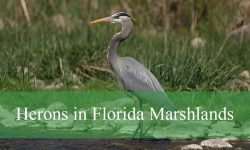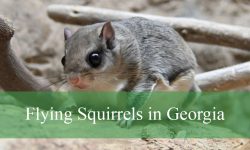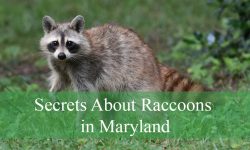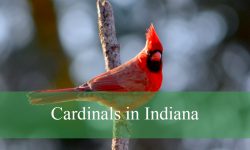From the vibrant Northern Cardinal singing in a backyard tree to the busy Belted Kingfisher skimming North Carolina’s rivers, birds bring life and color to every corner of the state. With forests, fields, and coastlines, North Carolina is a playground for birdwatchers of all levels.
In this guide, we’ll explore 45 common birds you’re likely to see across the state. Each entry includes clear identification tips, photos, and interesting facts to help you recognize and appreciate these feathered neighbors wherever you go.
Common Birds Found in North Carolina
Carolina Chickadee
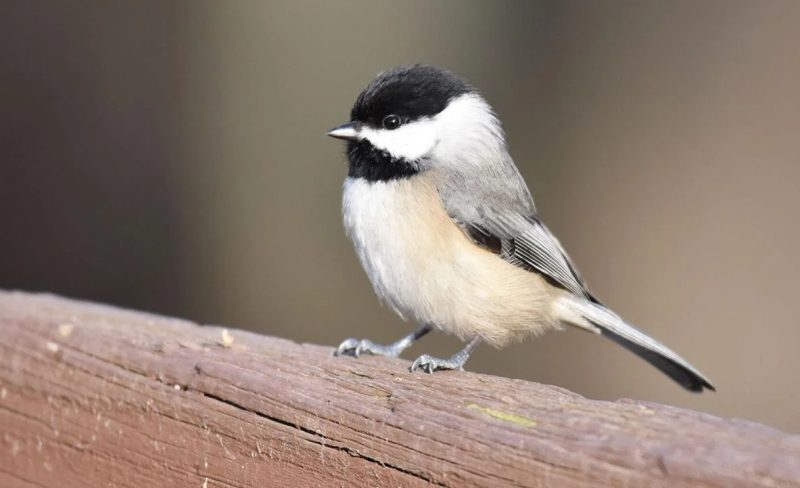
The Carolina Chickadee is a common backyard bird across North Carolina, often recognized by its black cap and bib, white cheeks, and soft gray body. At only 4–5 inches long, it is a small but energetic songbird, often seen flitting between branches or visiting feeders in mixed flocks during the winter. Their short, cheerful calls make them easy to identify even without a clear view.
Chickadees inhabit woodlands, forests, and residential areas, where they feed on insects, seeds, and berries. They are frequent visitors to bird feeders, especially when sunflower seeds and suet are available. Known for their acrobatic feeding style, chickadees often hang upside down while foraging among twigs and leaves.
During the breeding season, chickadees nest in tree cavities or birdhouses, where they line the space with soft materials such as moss, fur, and feathers. Females typically lay 5–8 eggs per clutch. Fun fact: Chickadees are remarkable for their memory, as they can hide seeds in hundreds of locations and remember where to retrieve them later, even months afterward.
Northern Cardinal
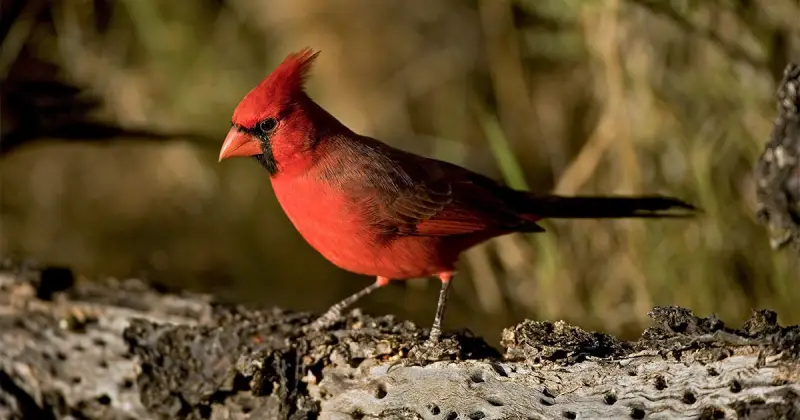
The Northern Cardinal is one of the most recognizable and beloved birds in North Carolina, easily spotted by its vivid colors and cheerful songs. Males display bright red plumage with a striking black mask around the face, while females are more subdued with warm brown feathers and reddish highlights on the wings and tail. Both sexes have a distinctive crest atop their head and a thick, cone-shaped beak, perfect for cracking seeds. On average, these birds measure about 8–9 inches long, making them medium-sized songbirds.
Cardinals are year-round residents in North Carolina, thriving in backyards, forests, and shrubby areas. They are highly adaptable and often visit bird feeders, especially during winter months when food is scarce. Their diet consists mostly of seeds, fruits, and insects, which they forage for on the ground or in low vegetation. They are also known for their strong pair bonds, often seen traveling together as mates throughout the year.
Breeding season begins in spring, when males sing loudly to defend territories and attract females. Females usually build cup-shaped nests in dense shrubs, where they lay 2–5 eggs per clutch. Fun fact: Northern Cardinals were chosen as the official state bird of North Carolina in 1943, and their bright plumage often brings a splash of color to snowy winter landscapes.
American Robin
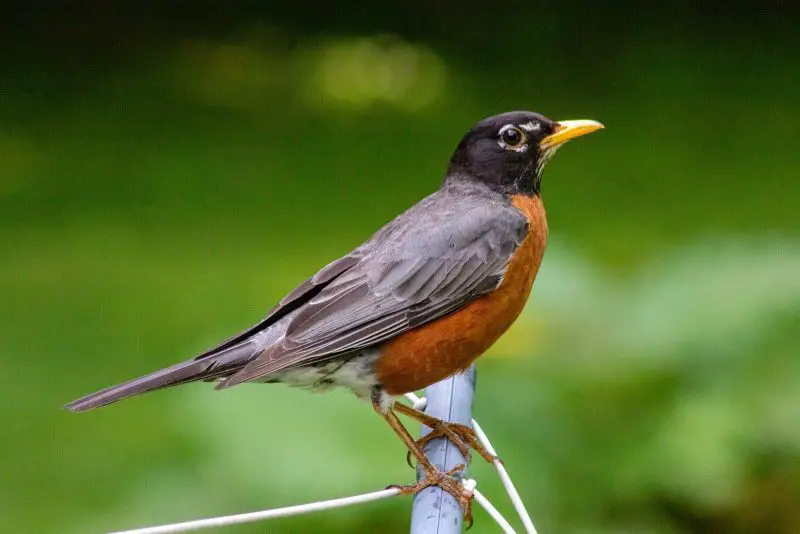
The American Robin is a familiar sight in North Carolina, especially during spring when its melodic song signals the arrival of warmer weather. With a reddish-orange breast, gray-brown back, and a distinctive yellow bill, this medium-sized bird is easy to recognize. Measuring around 9–11 inches in length, robins are larger than many backyard birds and are often seen hopping across lawns in search of food.
Robins are highly adaptable and can be found in suburban yards, parks, woodlands, and farmlands across the state. They primarily feed on earthworms, insects, and fruits, often tugging worms straight from the ground after a rainfall. In fall and winter, large flocks form to forage for berries and other available fruits, making them more social during colder months.
During breeding season, robins build nests out of mud and grass in trees, shrubs, and even on ledges of houses. They can raise two or three broods in one summer, with females laying about 3–5 eggs per clutch. Fun fact: American Robins are known to be among the first birds heard singing at dawn, earning them the nickname “early birds.”
Carolina Wren
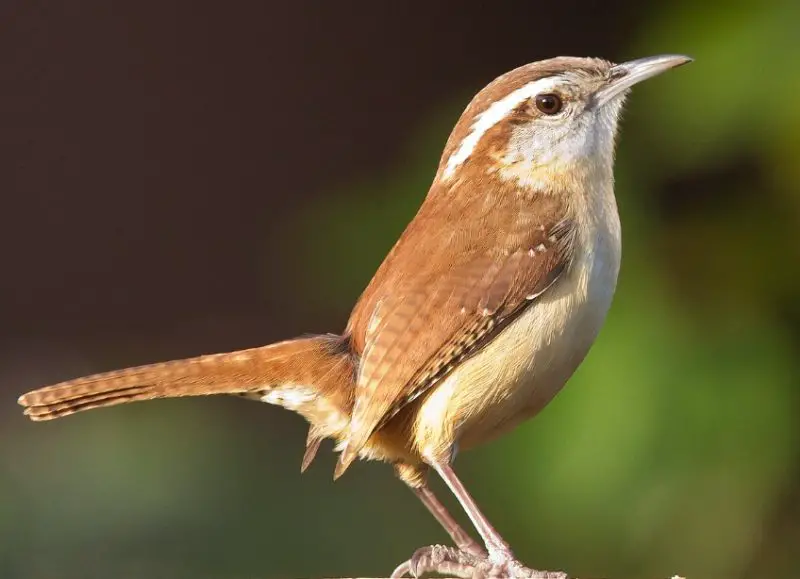
The Carolina Wren is a small but energetic bird that thrives in the warm climate of North Carolina. It is identified by its rich reddish-brown plumage, bold white eyebrow stripe, and slightly curved bill. Despite its small size, measuring only about 4–5 inches long, this bird has an impressively loud and musical song that can be heard throughout the year.
These wrens prefer habitats with dense vegetation, thickets, and brushy areas, but they are also frequent visitors to suburban gardens and backyards. They forage close to the ground, feeding mainly on insects, spiders, and other small invertebrates. Carolina Wrens are non-migratory and remain active even in winter, often using natural cavities or sheltered spaces to roost.
Breeding pairs remain together year-round, with males and females forming strong lifelong bonds. The female builds dome-shaped nests in a variety of places, from tree cavities to hanging baskets on porches. Each clutch contains about 4–6 eggs. Fun fact: Despite their small size, Carolina Wrens produce songs that are among the loudest of any North American wren species, filling woodlands and neighborhoods with cheerful notes.
Tufted Titmouse
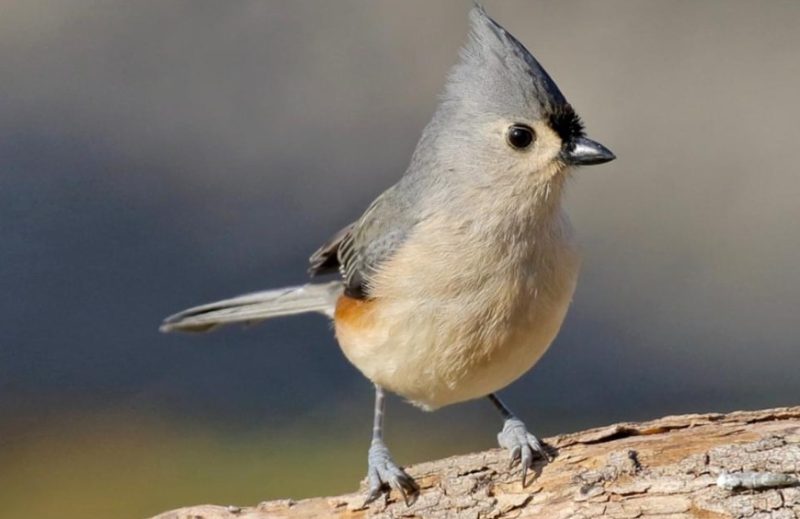
The Tufted Titmouse is another small but lively bird that can be found year-round in North Carolina. It is easily recognized by its soft gray feathers, large black eyes, and a pointed crest on its head. Measuring about 5–6 inches long, the Tufted Titmouse is slightly larger than a chickadee but shares many similar behaviors, including quick movements and an inquisitive nature.
These birds prefer deciduous and mixed woodlands, but they are also frequent visitors to backyards and feeders. Their diet includes insects, seeds, nuts, and berries, and they often cache food to eat later. Tufted Titmice are also known for their clear, whistled “peter-peter-peter” calls, which echo through forests and suburban areas alike.
During spring, they nest in tree cavities or birdhouses, usually lined with soft materials such as moss, fur, and feathers. A typical clutch contains 5–7 eggs. Fun fact: Tufted Titmice are curious birds that sometimes pluck hair from animals—or even humans—to line their nests, a quirky behavior that surprises many birdwatchers.
Blue Jay
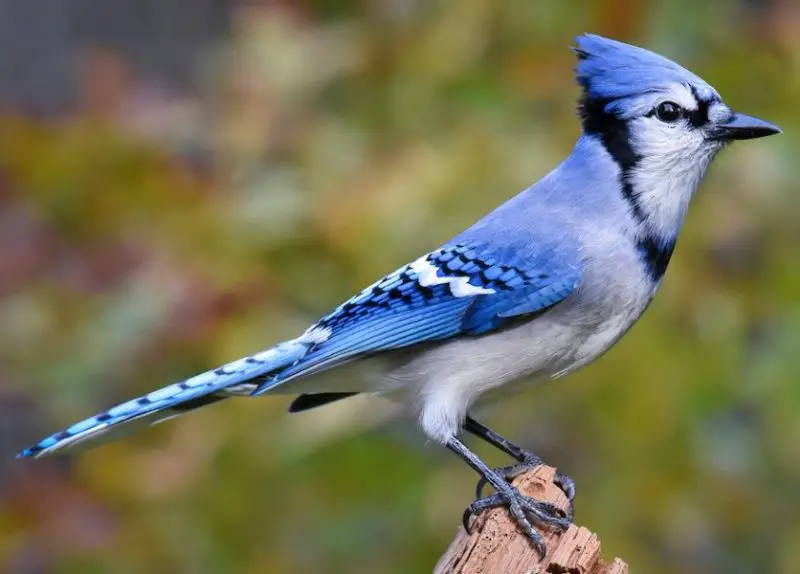
The Blue Jay is one of the most striking and intelligent birds found in North Carolina. It has bright blue feathers on its back, wings, and tail, with a white belly and a bold black collar across the neck. Its crest and loud, varied calls make it unmistakable. Blue Jays are medium-sized birds, averaging 9–12 inches in length, making them larger than many other common backyard species.
These birds are highly adaptable and thrive in forests, parks, and residential neighborhoods. Their diet includes acorns, seeds, insects, and occasionally small vertebrates. They are known for their bold personalities, often chasing away other birds to protect food sources. Blue Jays also play an important role in forest regeneration by caching acorns, some of which they forget, allowing new oak trees to grow.
During breeding season, Blue Jays build sturdy nests in trees, with females laying 3–6 eggs per clutch. Both parents take part in raising the young, which fledge after about three weeks. Fun fact: Blue Jays are excellent mimics and can imitate the calls of hawks, which they sometimes use to scare off other birds or predators.
American Goldfinch
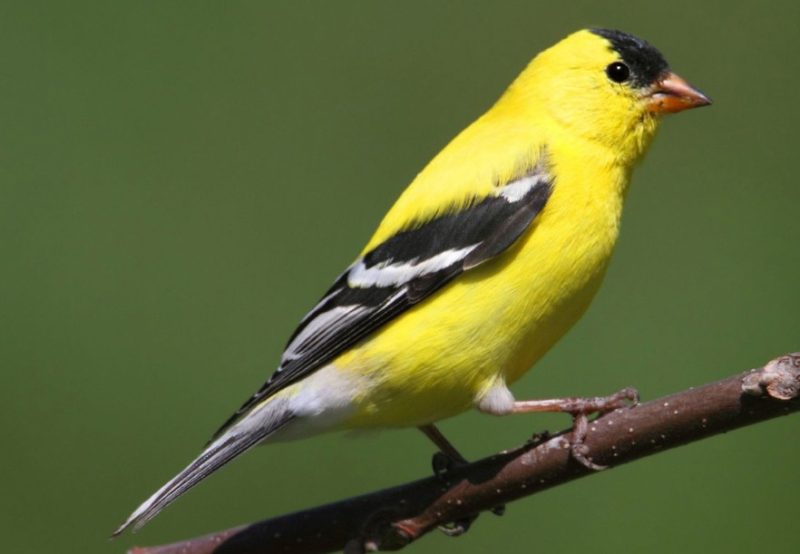
The American Goldfinch is a small, brightly colored songbird often found in open fields, meadows, and backyards across North Carolina. Males are especially striking in summer with their vivid yellow plumage, black wings, and a black cap on the head, while females are more subdued in olive-brown tones with touches of yellow. In winter, both sexes molt into duller plumage, making them less conspicuous. They measure about 4–5 inches long and are known for their bounding, undulating flight pattern.
These finches are granivores, feeding primarily on seeds from plants such as thistles, sunflowers, and dandelions. They are frequent visitors to backyard feeders, especially when nyjer (thistle) seed is available. Unlike many other songbirds, American Goldfinches breed later in the summer, timing their nesting with the peak abundance of seeds.
Breeding pairs build neat, cup-shaped nests lined with plant fibers and hair, usually placed in shrubs or trees. Females lay 4–6 pale blue eggs per clutch. Fun fact: American Goldfinches are among the few North American birds that are strictly vegetarian, even feeding their young a diet of regurgitated seeds rather than insects.
Eastern Bluebird
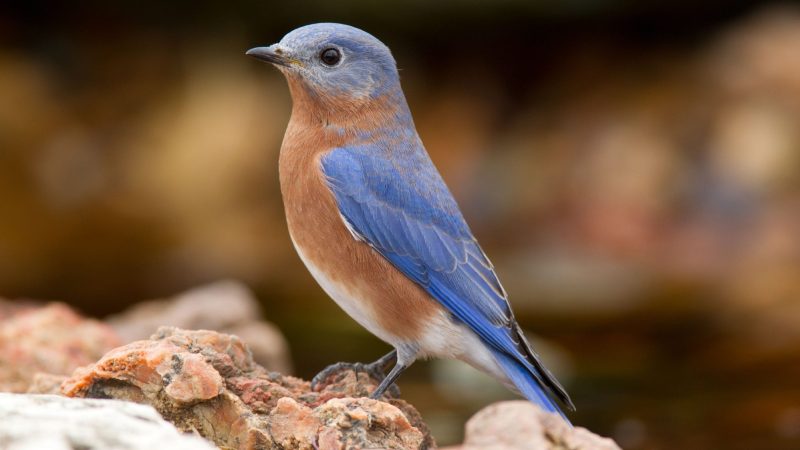
The Eastern Bluebird is one of the most iconic birds in North Carolina, cherished for its vibrant plumage and cheerful presence. Males have bright blue backs and wings with a warm reddish-orange chest, while females are softer in tone with grayish-blue wings and a paler breast. These birds measure about 6–8 inches long and are often seen perched on fence posts, wires, or low branches in open countryside.
Eastern Bluebirds prefer open habitats such as fields, meadows, orchards, and suburban yards with scattered trees. Their diet consists mainly of insects during the warmer months, including beetles, caterpillars, and grasshoppers, while in winter they rely more heavily on fruits and berries. They are cavity nesters and readily use birdhouses provided by homeowners.
Breeding typically begins in early spring, with females laying 3–7 pale blue eggs in a grass-lined nest inside a tree cavity or nest box. Bluebirds are capable of raising two to three broods in a single season. Fun fact: Once nearly in decline due to habitat loss and competition from invasive species like starlings, Eastern Bluebirds have made a strong comeback thanks to widespread nest box programs.
Red-bellied Woodpecker
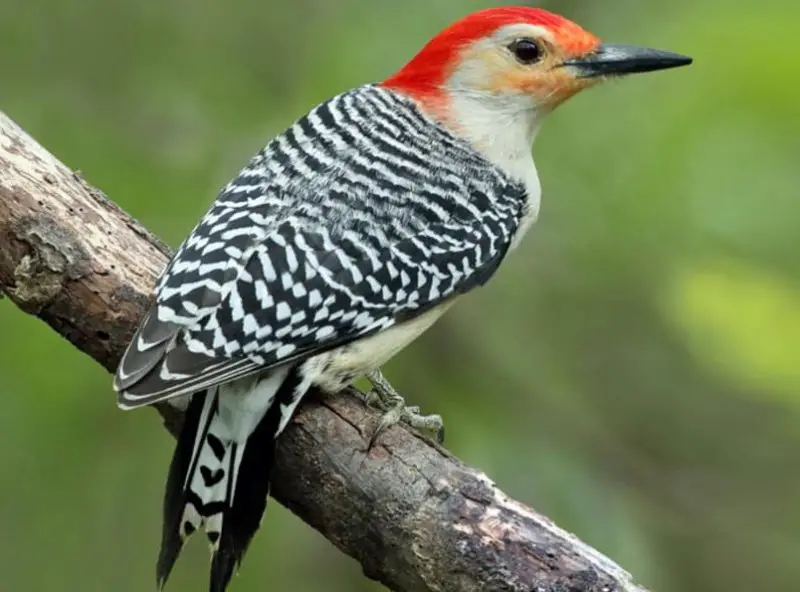
The Red-bellied Woodpecker is a medium-sized woodpecker common throughout North Carolina’s forests and suburban areas. Despite its name, the reddish tint on its belly is faint and often difficult to see. Its most noticeable feature is the striking red crown and nape on the head, along with its black-and-white barred back and wings. These birds measure about 9–10 inches long with a wingspan of 13–16 inches.
They thrive in deciduous and mixed woodlands but also adapt well to urban environments where mature trees are present. Their diet includes insects, nuts, seeds, and fruits, which they often store in tree crevices for later use. At feeders, they are frequent visitors, especially for suet and peanuts.
During breeding season, Red-bellied Woodpeckers excavate cavities in dead or decaying trees, where females lay 3–8 white eggs per clutch. Both parents share incubation and feeding duties. Fun fact: These woodpeckers have a loud, rolling “churr” call, which makes them one of the most vocal woodpecker species in the region.
Downy Woodpecker
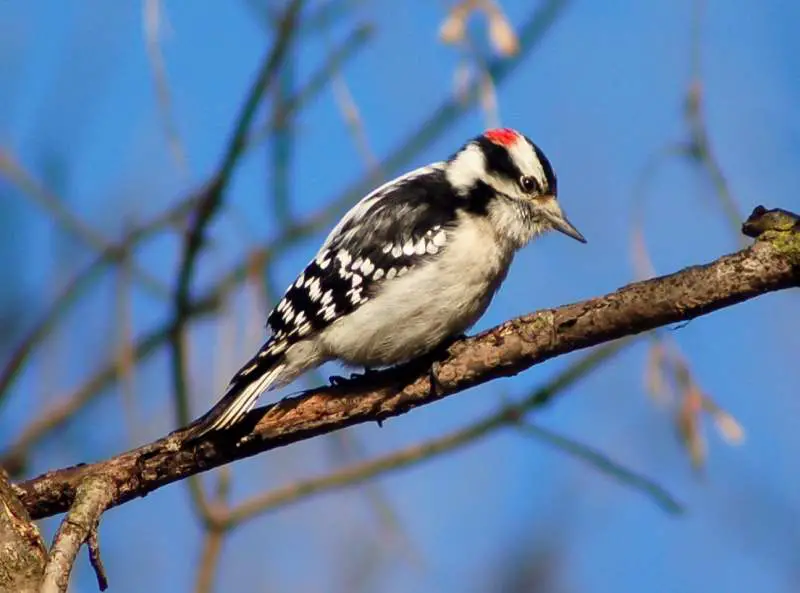
The Downy Woodpecker is the smallest woodpecker in North Carolina, measuring only 6–7 inches in length. It has a black-and-white checkered back, white underparts, and a small bill that is shorter than the width of its head. Males can be identified by the small red patch on the back of the head, while females lack this feature.
Downy Woodpeckers are widespread, found in forests, orchards, parks, and backyards across the state. They feed on insects, seeds, and berries, often visiting feeders for suet and sunflower seeds. Their small size and agility allow them to forage on thinner branches where larger woodpeckers cannot reach.
Breeding occurs in spring, when pairs excavate cavities in trees for nesting. Females lay 4–5 white eggs, and both parents share incubation and chick-rearing duties. Fun fact: The Downy Woodpecker’s drumming is softer and shorter than that of larger woodpeckers, making it a useful clue for identification in the field.
Hairy Woodpecker
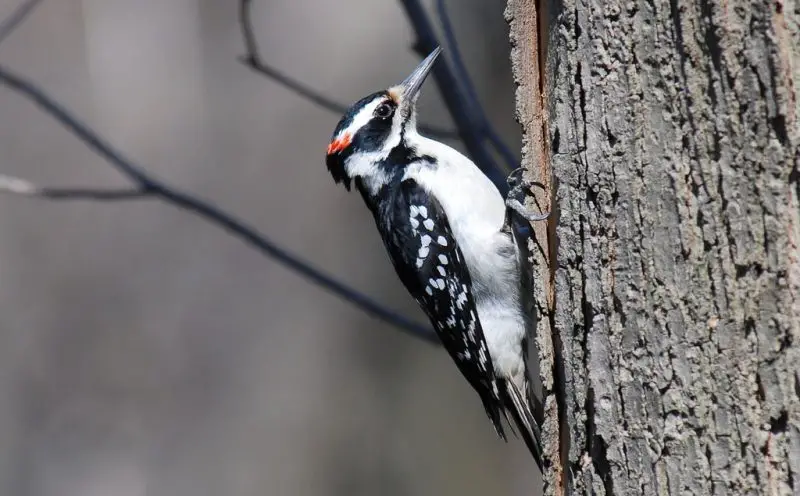
The Hairy Woodpecker is very similar in appearance to the Downy Woodpecker but is noticeably larger, measuring 9–10 inches long with a longer, more robust bill. It has black-and-white plumage, with males showing a small red patch on the back of the head. The similarity often causes confusion, but the bill size is a reliable way to distinguish the two.
Hairy Woodpeckers prefer mature forests with larger trees but are also found in wooded suburbs, parks, and orchards. Their diet includes beetles, ants, and larvae, which they extract from beneath bark using their strong bills. They also consume seeds and berries when insects are less abundant.
During breeding season, Hairy Woodpeckers excavate deep cavities in dead trees or limbs, where females lay 3–6 eggs. Both parents participate in raising the young. Fun fact: Hairy Woodpeckers are important for forest health, as their feeding helps control populations of wood-boring insects that could otherwise damage trees.
Pileated Woodpecker
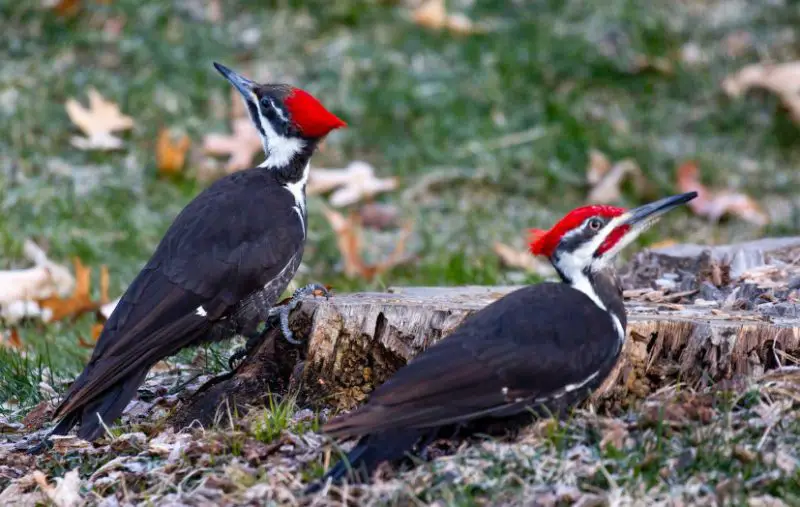
The Pileated Woodpecker is the largest woodpecker in North Carolina, measuring 16–19 inches long with a wingspan of up to 30 inches. It is strikingly recognized by its bold black body, white stripes along the face and neck, and a bright red crest. Its loud, resonant calls and powerful drumming are often heard before the bird is seen.
These impressive woodpeckers inhabit mature forests with large trees, especially bottomland hardwoods and mixed woodlands. They feed primarily on carpenter ants and wood-boring beetle larvae, chiseling large rectangular holes in trees to access insects. Their feeding excavations are so deep that they create habitats for other species, such as owls and bats.
Breeding occurs in spring, when pairs excavate large nest cavities in dead trees, which they reuse or enlarge over time. Females lay 3–5 white eggs, and both parents share incubation and care of the young. Fun fact: The Pileated Woodpecker’s striking appearance and behavior are believed to have inspired the famous cartoon character Woody Woodpecker.
Mourning Dove

The Mourning Dove is one of the most widespread and familiar birds in North Carolina, recognized for its slender, graceful body and soft, mournful cooing calls. It has a light brown to grayish body with black spots on the wings, a small head, and a long pointed tail edged in white. Adults measure about 9–13 inches long, making them medium-sized doves often seen perched on wires or foraging on the ground.
These doves thrive in open habitats such as fields, farmlands, suburban lawns, and roadsides. They primarily feed on seeds, grains, and small fruits, often foraging in large flocks during fall and winter. Mourning Doves are fast and direct flyers, capable of reaching speeds up to 55 miles per hour, which helps them evade predators.
During breeding season, pairs build flimsy stick nests in trees, shrubs, or even on man-made structures. Females usually lay two small white eggs, and pairs may raise multiple broods each year. Fun fact: Mourning Doves are one of the most abundant game birds in North America, yet their population remains strong due to their prolific breeding habits.
Rock Pigeon
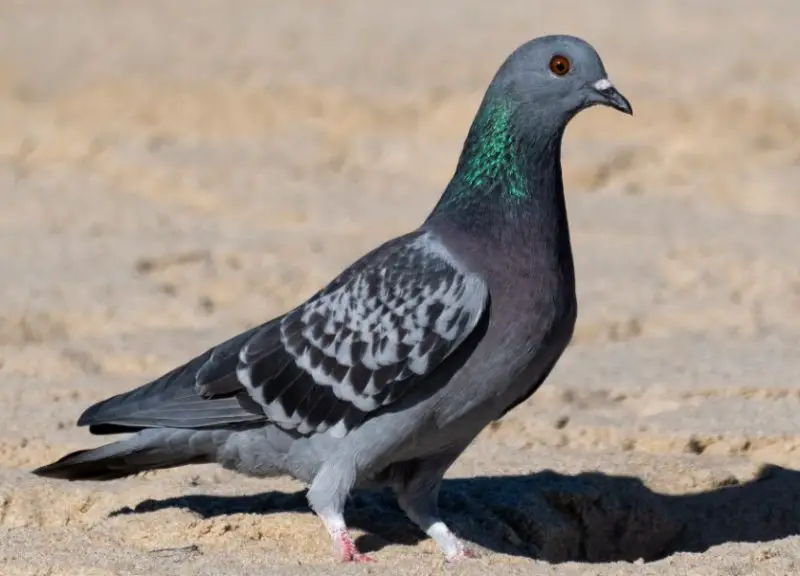
The Rock Pigeon, also known simply as the common pigeon, is a familiar sight in North Carolina’s cities and towns. These medium-to-large birds measure about 11–14 inches long and have a plump body, short legs, and a small head. Their plumage varies widely, but the typical form is gray with two black wing bars, iridescent green and purple on the neck, and a lighter rump.
Rock Pigeons are highly adaptable and thrive in urban areas, farmlands, and open spaces. They feed mainly on seeds, grains, and human food scraps, often gathering in large flocks in city squares or near agricultural fields. Their close association with people has made them one of the most widespread bird species worldwide.
Breeding can occur year-round, with pigeons nesting on building ledges, bridges, and other structures. They usually lay two eggs per clutch, and both parents take turns incubating and feeding the chicks with “pigeon milk,” a nutrient-rich secretion. Fun fact: Rock Pigeons were the first domesticated bird species, kept by humans for thousands of years for food, racing, and carrying messages.
House Finch
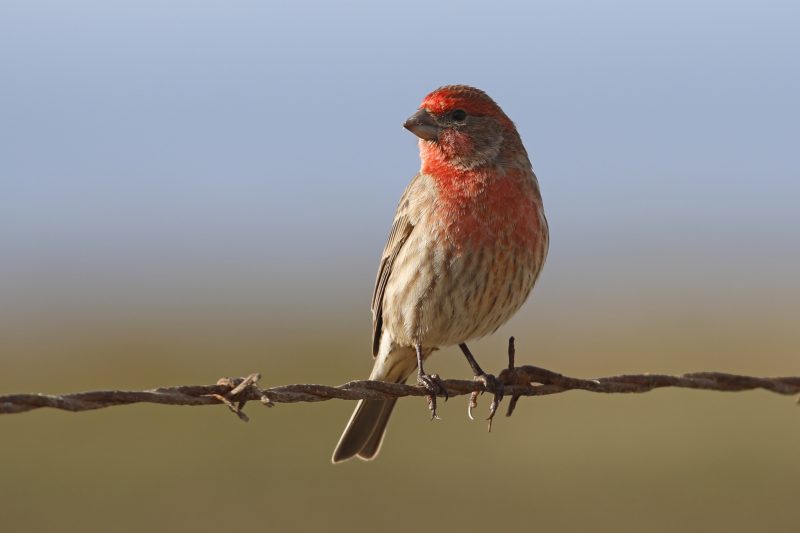
The House Finch is a small, lively bird commonly found in both rural and urban areas of North Carolina. Males are recognized by their red foreheads, throats, and breasts, which contrast with streaked brown backs and wings. Females lack the red coloring and are streaky brown overall. These birds measure about 5–6 inches long and are often seen perched on shrubs or visiting feeders.
They are highly adaptable and thrive in backyards, parks, farms, and city environments. House Finches primarily feed on seeds, fruits, and buds, often flocking together in groups during the colder months. At feeders, they are particularly fond of sunflower seeds. Their cheerful, warbling song is a common sound in suburban neighborhoods.
Breeding occurs in spring, with females building cup-shaped nests in trees, hanging baskets, or even on ledges of houses. Each clutch typically contains 2–6 eggs. Fun fact: House Finches were originally native to the western United States but were introduced to the East in the 1940s, where they quickly established themselves and spread widely.
Purple Finch
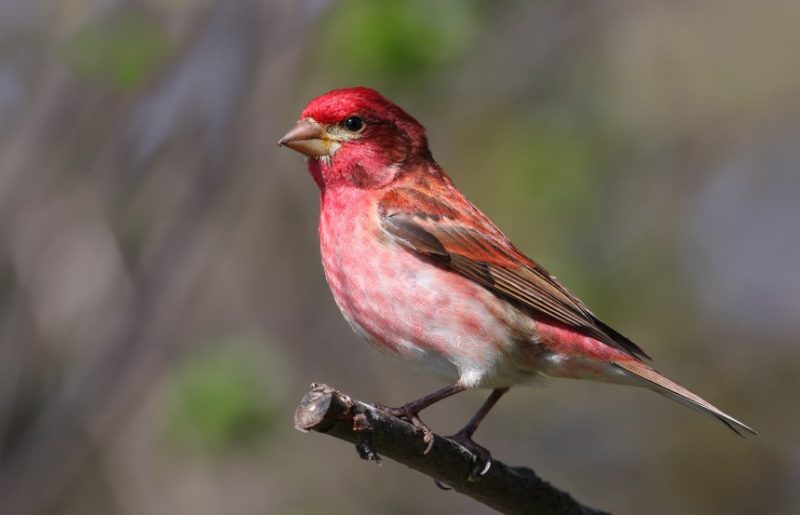
The Purple Finch is another colorful finch species found in North Carolina, though it is less common than the House Finch. Males display a raspberry-red wash over the head, breast, and back, while females are streaky brown with bold facial markings. Slightly larger than the House Finch, Purple Finches measure about 5–6.5 inches long.
These birds prefer mixed forests, woodland edges, and suburban yards, especially where feeders are present. Their diet consists of seeds, berries, and insects, and they are especially fond of sunflower seeds when visiting feeders. In North Carolina, they are most often seen during the winter months as part of their seasonal movement.
Nesting occurs in coniferous or mixed forests, with females constructing cup-shaped nests out of twigs, grasses, and rootlets. Clutches usually contain 3–5 pale greenish-blue eggs. Fun fact: The Purple Finch was once described by poet Robert Ridgway as a “sparrow dipped in raspberry juice” because of the male’s vibrant coloring.
Eastern Towhee
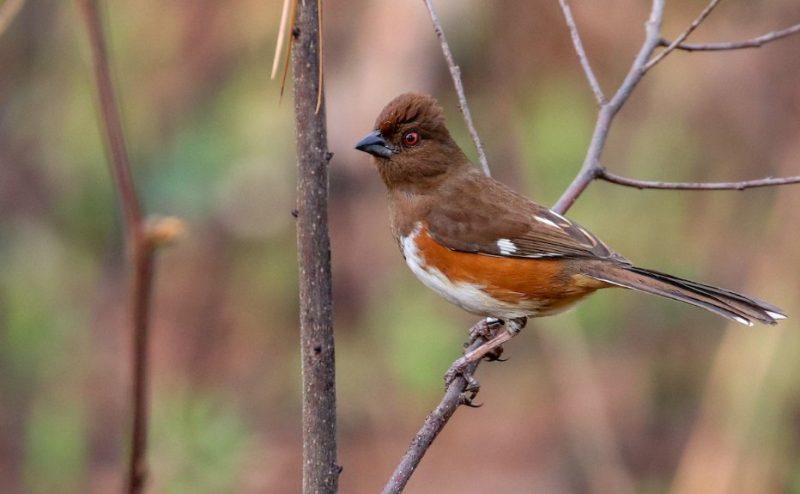
The Eastern Towhee is a striking songbird that is common in North Carolina’s brushy areas and forest edges. Males have jet-black upperparts, a rufous-red flank, and a white belly, while females are similar but with brown replacing the black. Both sexes have long tails with white corners that flash in flight. They are medium-sized, measuring about 6–8 inches long.
Towhees forage mostly on the ground, using a unique two-footed scratching motion to uncover seeds, insects, and fruits hidden beneath leaves. They prefer habitats with dense underbrush, thickets, and overgrown fields, making them frequent visitors to backyard edges and wooded lots. Their loud “drink-your-tea” song is a common sound in spring and summer.
Breeding season runs from April to August, with nests placed low in shrubs or on the ground. Females lay 2–6 eggs per clutch, often raising two broods per year. Fun fact: Eastern Towhees were once called “Rufous-sided Towhees,” but the name was split when western populations were recognized as a separate species.
Song Sparrow
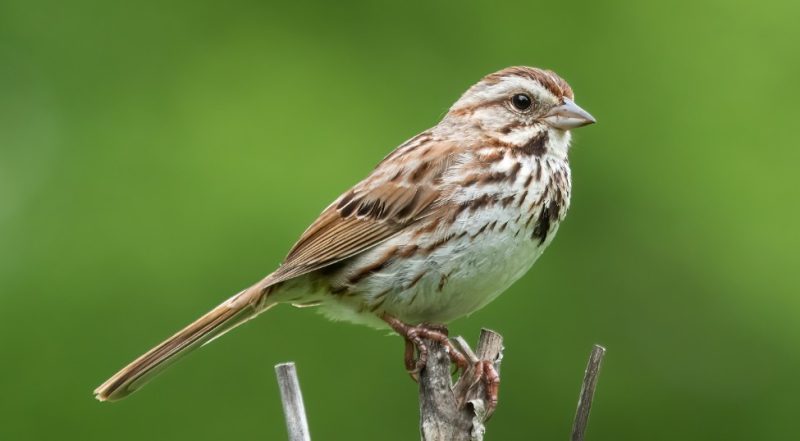
The Song Sparrow is one of the most widespread sparrows in North Carolina, identifiable by its streaky brown plumage, a gray face with a brown eye line, and a central dark spot on the breast. Measuring 5–7 inches long, they are medium-sized sparrows with a rounded tail and a sturdy bill adapted for seed-eating.
These sparrows are found in a variety of habitats, including marshes, meadows, forest edges, and suburban gardens. Their diet includes seeds, insects, and fruits, and they are frequent visitors to backyard feeders. Song Sparrows are well known for their melodious and variable songs, which males use to establish territories and attract mates.
Nesting occurs from spring through summer, with females building cup-shaped nests low to the ground in shrubs or tall grasses. Each clutch usually contains 3–5 eggs. Fun fact: Song Sparrows exhibit significant regional variation in their songs, with different populations singing slightly different versions, almost like local dialects.
Chipping Sparrow
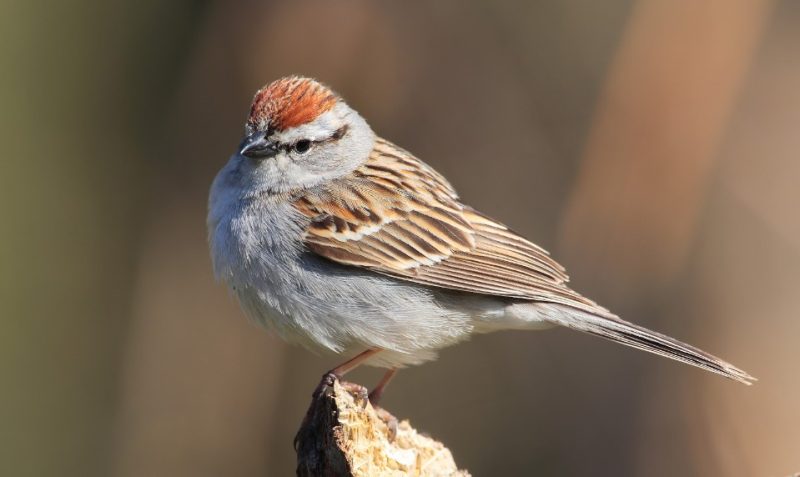
The Chipping Sparrow is a small, slim songbird commonly found across North Carolina, especially in open woodlands, fields, and suburban areas. During breeding season, adults are easily recognized by their bright rufous cap, white eyebrow, and black eye line. Outside of summer, their plumage is duller, but their slender build and sharp “chip” call remain distinctive. They measure about 4.5–5.5 inches in length, making them slightly smaller than the Song Sparrow.
Chipping Sparrows feed mainly on seeds and insects, often foraging on the ground in flocks. In backyards, they are frequent visitors to feeders offering millet and other small seeds. These birds are adaptable and often seen perching on fences, shrubs, and low branches while scanning for food.
Breeding begins in spring, with females building neat, grass-lined nests in shrubs or small trees. Clutches usually contain 3–5 pale blue eggs, and pairs may raise two broods in a season. Fun fact: Chipping Sparrows are known for their rapid, dry trill song, which can sound like a mechanical buzz echoing through open fields and neighborhoods.
White-throated Sparrow
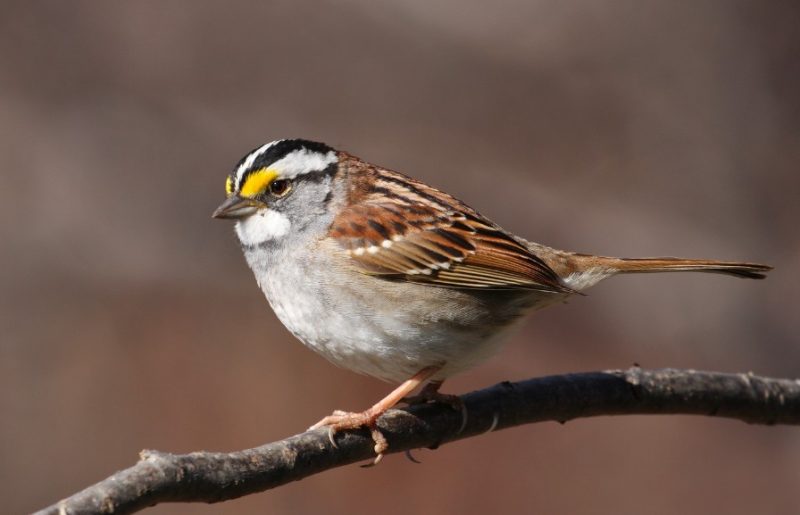
The White-throated Sparrow is a winter visitor in North Carolina, bringing color and song to woodlands and backyard feeders. It is distinguished by its white throat patch, black-and-white striped crown, and bright yellow spots between the eyes and bill. These sparrows measure 6–7 inches long and are slightly larger than the Chipping Sparrow.
They prefer shrubby woodlands, thickets, and backyard edges, where they forage on the ground for seeds, fruits, and insects. During winter, they are frequent feeder visitors, especially when millet and sunflower seeds are available. They are social birds, often found in loose flocks, scratching in the leaf litter beneath trees.
Breeding occurs farther north in Canada, but during migration and winter in North Carolina, their sweet, whistled song—often described as “Old Sam Peabody, Peabody, Peabody”—is sometimes heard. Fun fact: White-throated Sparrows come in two color morphs, white-striped and tan-striped, and pairs often form between birds of different morphs.
Dark-eyed Junco
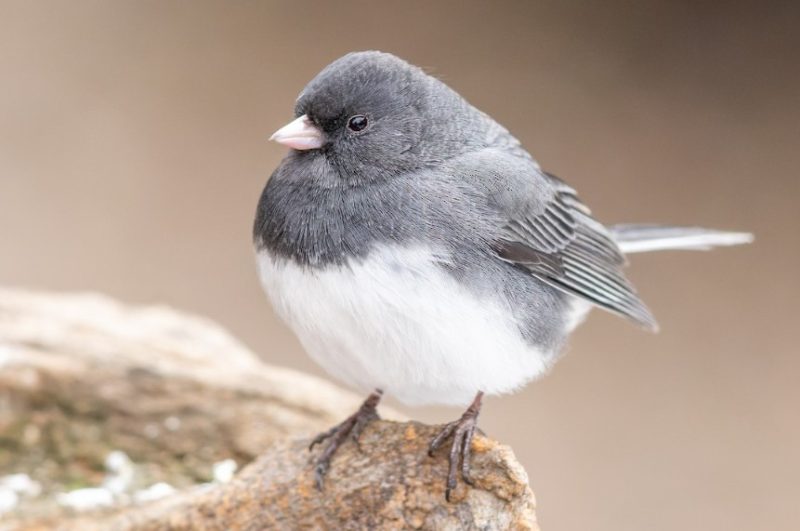
The Dark-eyed Junco, often called the “snowbird,” is a familiar winter visitor in North Carolina. These sparrows are small, measuring 5–6.5 inches long, with slate-gray plumage, a white belly, and a pale pink bill. Their flashing white outer tail feathers are especially noticeable in flight, helping distinguish them from other sparrows.
Juncos prefer open woodlands, fields, and backyard feeding areas during the colder months. They feed primarily on seeds, often foraging on the ground beneath feeders where they scratch at the soil and leaf litter. Insects supplement their diet during the breeding season.
Although they breed farther north and in higher elevations, they are abundant in North Carolina during winter. Fun fact: Dark-eyed Juncos are sometimes referred to as “snowbirds” because large flocks often appear just as winter weather arrives, signaling the change of seasons.
Northern Mockingbird
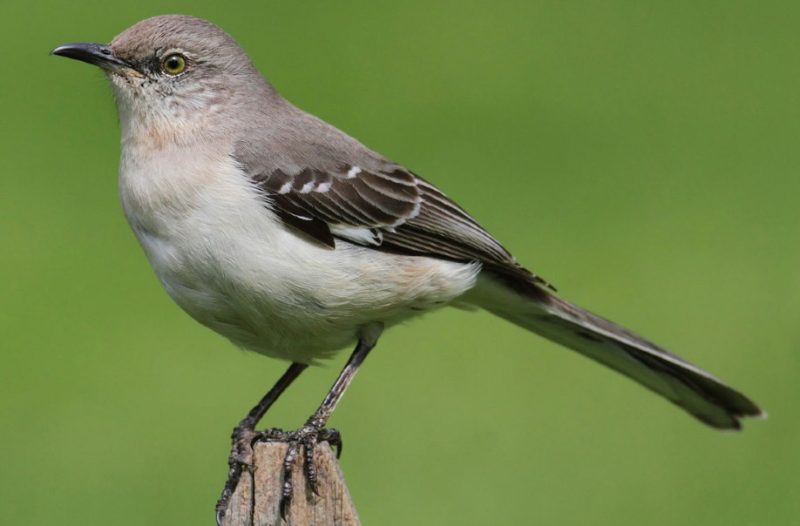
The Northern Mockingbird is a year-round resident of North Carolina and one of the most vocal birds in the state. It is medium-sized, measuring 8–10 inches long, with gray plumage, a white belly, and distinctive white wing patches that are obvious in flight. Its long tail and slender body give it a sleek appearance.
Mockingbirds are famous for their ability to mimic the songs and calls of other birds, as well as sounds from their surroundings. A single male can learn and repeat dozens of songs, often singing loudly from high perches during the day and even into the night. They are highly territorial and aggressive when defending nests or food sources.
Nesting begins in spring, with pairs building twig nests in shrubs or small trees. Females typically lay 2–6 eggs, and pairs may raise multiple broods in a season. Fun fact: Because of their remarkable vocal ability, Northern Mockingbirds have been celebrated in literature, music, and even designated as the state bird of several U.S. states.
Gray Catbird
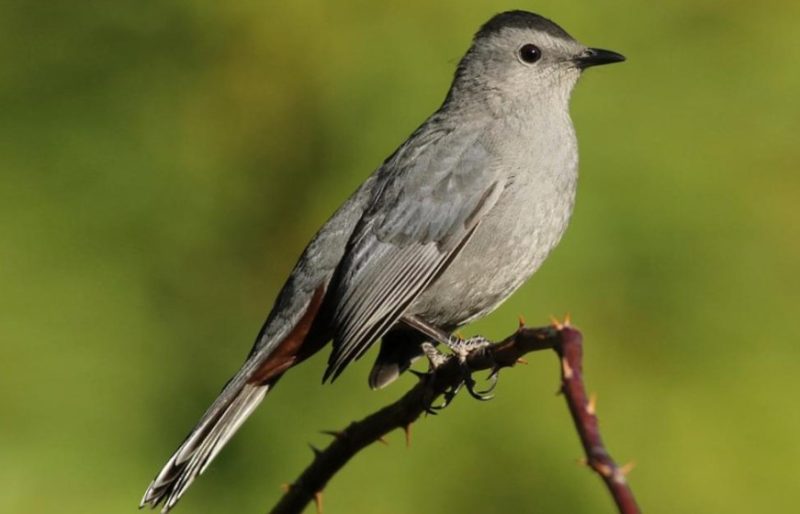
The Gray Catbird is a secretive yet vocal bird that inhabits thickets, forest edges, and suburban gardens in North Carolina. As its name suggests, it is slate-gray overall with a darker cap and a rusty patch under the tail. It measures 8–9 inches in length, making it similar in size to the Northern Mockingbird.
Like the mockingbird, the Gray Catbird is a skilled mimic, incorporating other bird songs and environmental sounds into its own long, rambling song. However, it is best known for its harsh “mew” call, which resembles the sound of a cat and often gives away its presence in dense vegetation.
Breeding season begins in spring, with nests built low in shrubs or tangles of vines. Females usually lay 2–5 blue-green eggs, and both parents care for the young. Fun fact: Catbirds belong to the same family as mockingbirds and thrashers, all known for their mimicking abilities, but catbirds are often the most secretive and hidden among them.
Brown Thrasher

The Brown Thrasher is a large, striking songbird commonly found in North Carolina’s brushy habitats. It has a rich reddish-brown back, heavily streaked underparts, and bright yellow eyes. Measuring 11 inches long, it is larger than a mockingbird and has a slightly curved bill adapted for foraging in leaf litter.
Brown Thrashers are skilled singers, capable of producing more than 1,000 song variations, the largest known repertoire of any North American bird. They typically repeat each phrase twice, making their songs distinct from the continuous flow of mockingbirds. These birds are territorial and often defend their nesting areas aggressively.
They prefer dense thickets, hedgerows, and forest edges, where they forage for insects, seeds, and fruits on the ground. Nests are usually built low in shrubs or small trees, with females laying 3–5 eggs per clutch. Fun fact: Despite their bold songs, Brown Thrashers are often shy and secretive, slipping quietly into cover when approached too closely.
American Crow
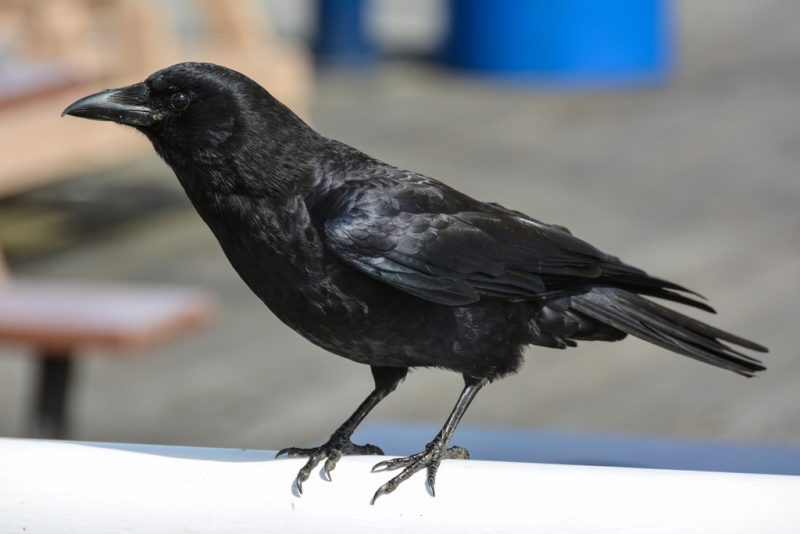
The American Crow is a familiar bird across North Carolina, recognized by its glossy black plumage, stout bill, and loud “caw” calls. It measures about 16 to 20 inches in length with a wingspan of around 33 to 39 inches, making it one of the larger common backyard birds. Its all-black feathers, strong flight, and confident behavior make it easy to identify, even from a distance.
Highly intelligent, American Crows are known for problem-solving skills, tool use, and complex social structures. They feed on a wide variety of foods, including insects, grains, fruits, carrion, and even small animals. Often seen in groups, they can gather in large communal roosts during winter, creating a noisy spectacle at dusk.
Crows inhabit both rural and urban areas, adapting well to city parks, farmland, and forests. During breeding season, pairs build bulky stick nests high in trees and fiercely defend their young. A fun fact is that American Crows can recognize human faces and may remember people who have threatened them, passing this knowledge to their flock.
Fish Crow
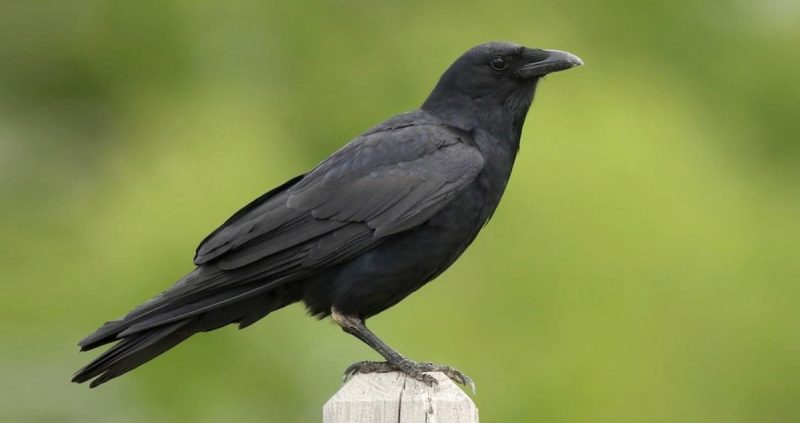
The Fish Crow resembles the American Crow but is slightly smaller, with a length of 14 to 16 inches and a wingspan of 27 to 30 inches. Its plumage is entirely black, though it often appears glossier in sunlight. The easiest way to distinguish it from the American Crow is by its nasal, “uh-uh” call, which sets it apart.
These crows are commonly found near water in North Carolina, such as coastal regions, rivers, and lakes. As their name suggests, Fish Crows eat aquatic foods like fish, shellfish, and crabs, though they also consume insects, grains, and carrion. They are social birds, often mixing with American Crows, which makes identification by sight alone challenging.
Breeding typically occurs in woodlands near water, where they construct large nests of sticks. Outside of nesting season, Fish Crows may gather in large flocks. A fun fact about them is that they have been observed stealing food from other birds, including gulls and herons, showcasing their adaptability and opportunistic nature.
European Starling
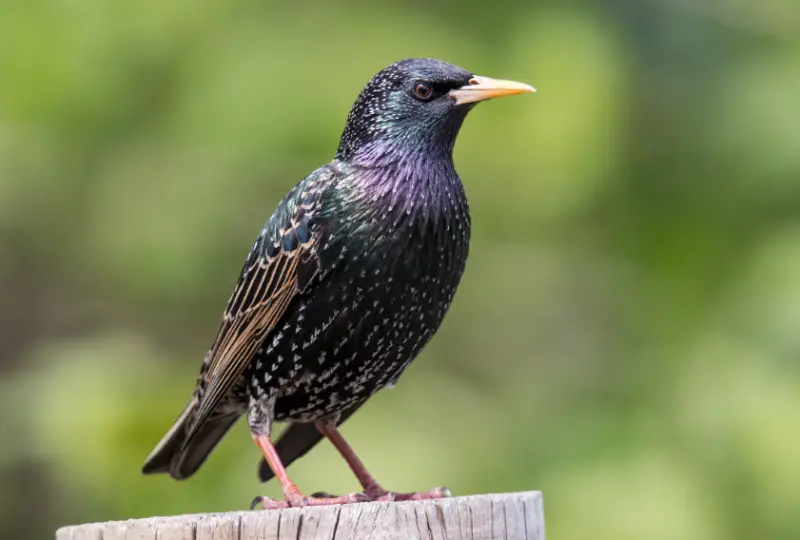
The European Starling is a non-native bird in North Carolina, introduced from Europe in the late 1800s. Adults are about 8 to 9 inches long with a wingspan of 12 to 16 inches. Their glossy black plumage shines with purple and green iridescence, and in winter, they are speckled with white spots. Their long, yellow bill in summer turns darker during winter months.
Starlings are known for their noisy, varied calls and ability to mimic other bird species. They often forage in large flocks, feeding on insects, fruits, and grains. Their aggressive behavior allows them to compete with native species for nesting sites, especially in cavities used by woodpeckers and bluebirds.
These birds thrive in open fields, towns, and agricultural areas. They nest in cavities, buildings, and even streetlights. A fun fact about European Starlings is their mesmerizing murmurations, where thousands of birds form shifting patterns in the sky—a breathtaking natural spectacle.
Common Grackle
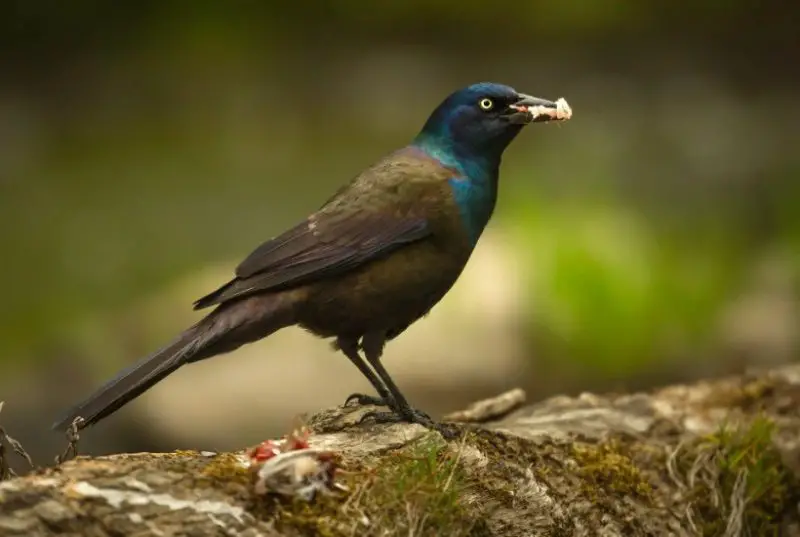
The Common Grackle is a large blackbird with striking iridescent feathers that shimmer in shades of purple, blue, and bronze. It measures 11 to 13 inches long with a wingspan of 14 to 18 inches. Its long tail, keel-shaped body, and piercing yellow eyes give it a bold and somewhat intimidating appearance.
Grackles are opportunistic feeders, eating insects, seeds, fruits, and even small vertebrates. They often forage in flocks and are known to raid bird feeders and agricultural fields. Their loud, metallic calls and social nature make them highly noticeable in both urban and rural areas.
In North Carolina, they nest in colonies, often choosing trees near wetlands or open fields. Their nests are bulky structures made from grasses and twigs. A fun fact is that Common Grackles can crack open acorns and corn kernels with their strong bills, a skill not many birds of their size possess.
Red-winged Blackbird
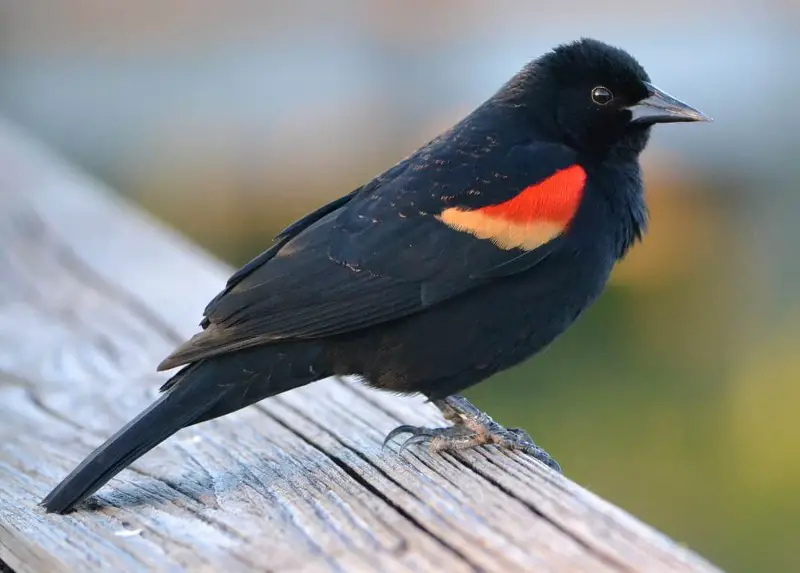
The Red-winged Blackbird is one of the most recognizable birds in North Carolina wetlands. Males are glossy black with bright red and yellow shoulder patches, while females are streaky brown and resemble large sparrows. They measure about 7 to 9 inches long with a wingspan of 12 to 16 inches.
These birds are often seen perched on cattails, fence posts, or wires, loudly singing their distinctive “conk-la-ree” call. They primarily feed on insects during summer and switch to seeds and grains in the colder months. During migration and winter, they may form large flocks with other blackbirds and starlings.
Red-winged Blackbirds breed in marshes and wet meadows, where males defend territories aggressively against intruders. Females weave cup-shaped nests among dense vegetation. A fun fact is that males can mate with multiple females, sometimes maintaining harems of up to 15 mates.
Brown-headed Cowbird

The Brown-headed Cowbird is a small blackbird with a unique reproductive strategy. Males are glossy black with a chocolate-brown head, while females are plain gray-brown. They measure about 7 to 8 inches in length with a wingspan of 12 to 15 inches.
Cowbirds are best known for being brood parasites, meaning they lay their eggs in the nests of other bird species. Over 200 species have been recorded raising cowbird chicks, often at the expense of their own young. They forage in open fields, lawns, and pastures, feeding on seeds and insects, often in mixed flocks.
In North Carolina, they are widespread in farmlands, grasslands, and suburban areas. Despite their parasitic behavior, they play an interesting ecological role. A fun fact is that some host species, like the Yellow Warbler, may build a new nest layer over cowbird eggs to protect their own clutch.
Indigo Bunting
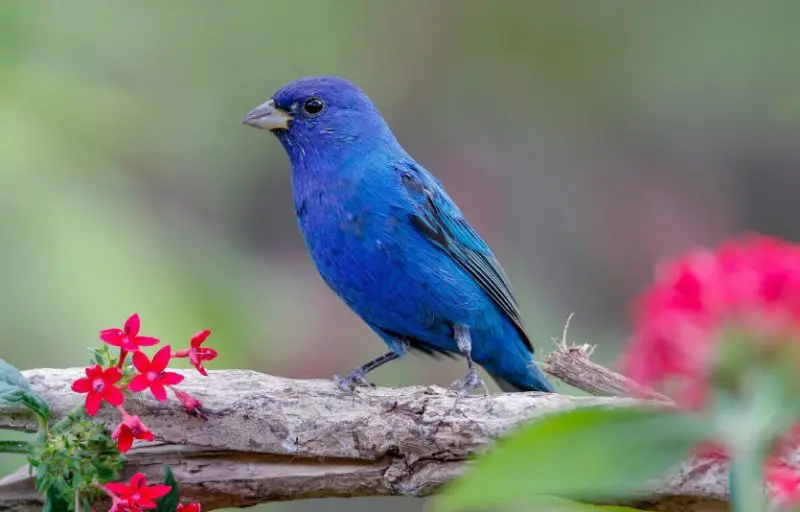
The Indigo Bunting is one of North Carolina’s most dazzling summer visitors, with males showing off bright, shimmering blue plumage that seems to glow in the sunlight. Females, in contrast, are brown with subtle streaks, making them much harder to spot in dense vegetation. These birds are small, averaging about 4.5 to 5 inches in length, and they are often recognized by their sharp, cheerful song that males deliver persistently during breeding season.
In North Carolina, Indigo Buntings favor open habitats like weedy fields, woodland edges, and shrubby areas where they can forage for seeds and insects. They are also common along rural roadsides and clearings. During summer, they are a familiar sight perched on tall plants or fences, singing loudly to defend territory. They migrate south in the winter, spending their colder months in Central America and the Caribbean.
Breeding takes place from May through August, with females building well-hidden cup-shaped nests low in shrubs. A fun fact about Indigo Buntings is that males use the stars to navigate during their long nocturnal migrations, an extraordinary adaptation that guides them across vast distances with precision.
Ruby-throated Hummingbird

The Ruby-throated Hummingbird is the only hummingbird species that breeds in North Carolina, easily recognized by its tiny size, rapid wingbeats, and the brilliant ruby-red throat of the male. Females are green above and pale below, lacking the male’s bright throat patch but sharing the same slender, iridescent appearance. Measuring just 3 to 3.5 inches long, these birds are marvels of agility and speed, capable of hovering in midair with remarkable control.
In North Carolina, they are most often seen in gardens, woodlands, and meadows where flowers are abundant. They feed primarily on nectar from tubular flowers but also consume small insects and spiders for protein. During the warmer months, many homeowners attract them with nectar feeders, enjoying their buzzing visits around patios and porches. These birds migrate long distances each year, often flying nonstop across the Gulf of Mexico to reach wintering grounds in Central America.
Ruby-throated Hummingbirds breed in late spring and summer, with females building delicate nests out of plant down and spider silk, often camouflaged on tree branches. A fun fact is that despite their tiny size, their wings can beat up to 53 times per second, and their hearts can race at over 1,200 beats per minute during flight.
Belted Kingfisher

The Belted Kingfisher is a striking bird found across North Carolina’s waterways, recognized by its large head, shaggy crest, and strong bill. Both sexes are slate-blue with white underparts, but females are unique in having an extra rusty band across the belly, making them more colorful than males—a rare trait among birds. These kingfishers are medium-sized, measuring about 11 to 14 inches long, and are most often spotted perched on branches overlooking rivers, lakes, and ponds.
Their behavior is unmistakable: they hover briefly before diving headfirst into the water to catch fish, their primary food source. They also eat aquatic insects, small amphibians, and even crustaceans. Their rattling call, often heard before they are seen, is a familiar sound along waterways in North Carolina. Unlike many birds, Belted Kingfishers dig burrows in sandy banks where they nest, tunneling several feet deep to protect their eggs and young from predators.
Breeding occurs in spring and summer, with both parents sharing duties of incubation and feeding. A fascinating fact is that Belted Kingfishers can actually close their eyes and use special membranes when diving, relying on sight adjustments to account for water refraction, allowing them to strike fish with precision.
Eastern Phoebe
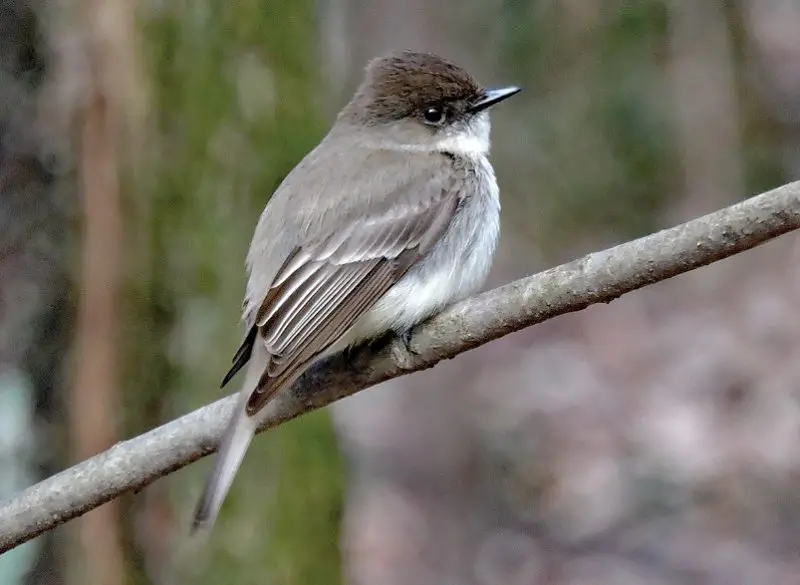
The Eastern Phoebe is a small flycatcher that makes its presence known in North Carolina with its gentle “fee-bee” call. It has a modest appearance with grayish-brown upperparts, a pale belly, and a slightly darker head. At about 5.5 to 6.7 inches long, it is often identified by its habit of wagging its tail downward while perched, a behavior unique among small flycatchers.
Phoebes thrive in woodland edges, farmlands, and near water, often nesting around human structures like barns, bridges, and porches. They are adept insect hunters, darting out from perches to snatch flies, beetles, and moths in midair. While insects are their main diet, they will also consume berries during colder months. In North Carolina, they are among the earliest spring arrivals, with some overwintering in milder parts of the state.
For breeding, they construct mud-based nests on ledges or beams, often reusing the same nest sites year after year. A fun fact is that Eastern Phoebes were the first birds ever banded in North America, by John James Audubon in 1804, making them historically significant in ornithology.
Eastern Kingbird
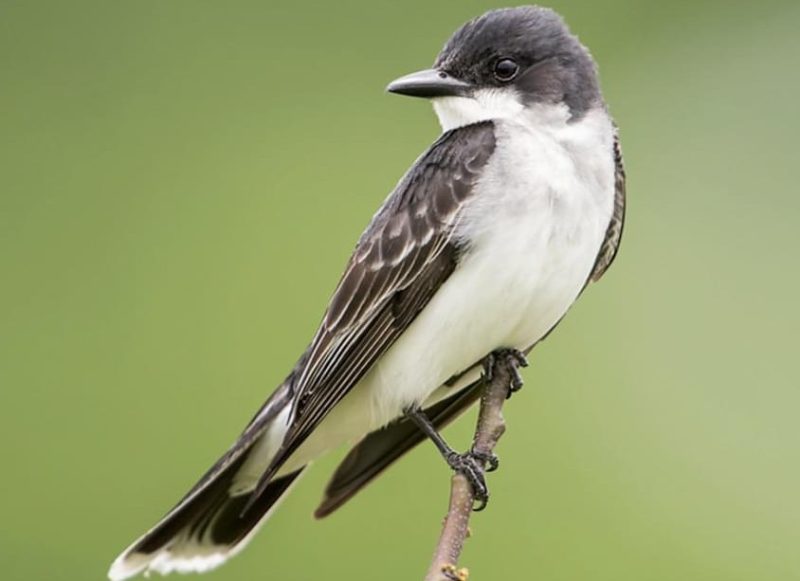
The Eastern Kingbird is a bold and aggressive bird easily recognized by its sleek black upperparts, white underparts, and distinctive white-tipped tail. Measuring about 7.5 to 9 inches long, it often perches conspicuously on fences, treetops, or wires, scanning for flying insects. Their upright posture and sharp call make them easy to identify in open landscapes.
In North Carolina, Eastern Kingbirds inhabit fields, orchards, and forest edges, where they feed on flying insects like dragonflies, grasshoppers, and wasps. They are fearless defenders of their nesting territories, often seen chasing away crows, hawks, and much larger birds with surprising aggression. This protective behavior makes them one of the most vigilant parents in the bird world.
Breeding season runs from late spring through summer, with nests built high in trees or shrubs, typically near open fields. A fascinating fact about Eastern Kingbirds is that while they primarily eat insects in summer, during migration they switch to a fruit-heavy diet, helping them store energy for their long journey to South America.
Great Crested Flycatcher
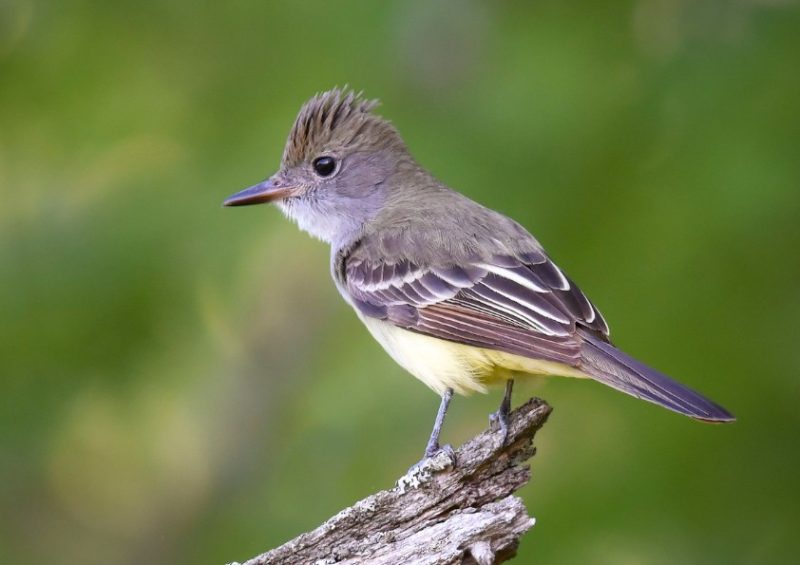
The Great Crested Flycatcher is one of North Carolina’s larger flycatchers, easily identified by its gray head and breast, yellow belly, and reddish-brown tail and wings. Measuring around 8 to 10 inches long, it is often heard before seen, producing loud, rolling calls that echo through woodlands. Their upright posture and bright colors make them a striking presence in forested areas.
They prefer mature forests, wooded edges, and suburban areas with tall trees, where they perch high in the canopy to hunt insects. Unlike some flycatchers, they will also eat fruits and berries, particularly during migration. Their foraging style involves sallying out from a perch to catch insects in midair or plucking them from foliage. They arrive in North Carolina in spring and remain through summer before migrating to Central and South America.
Breeding begins in late spring, and these birds are cavity nesters, often using old woodpecker holes or nest boxes. A fun fact is that Great Crested Flycatchers frequently line their nests with shed snake skins, a unique habit thought to deter predators from approaching their young.
Barn Swallow
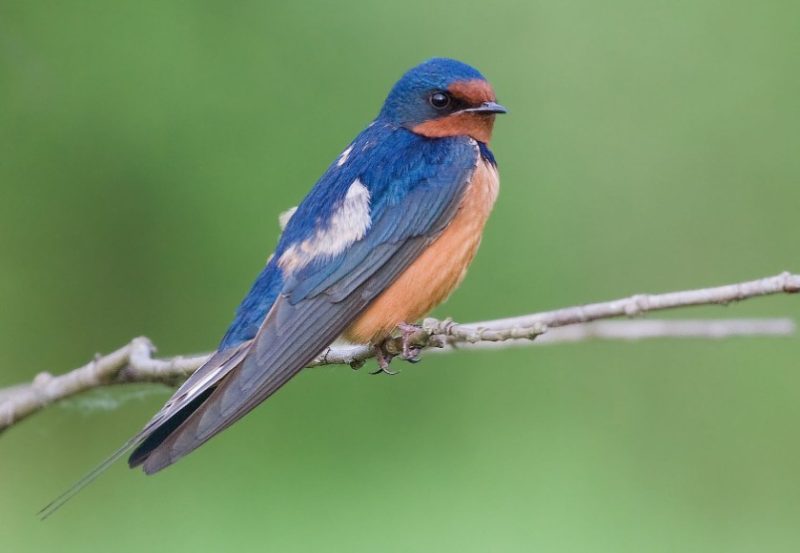
The Barn Swallow is a graceful bird recognized by its long, forked tail and sleek, streamlined body. Its glossy blue back contrasts beautifully with its reddish throat and buff underparts, making it easy to spot in open fields and near farms. These swallows are expert fliers, often darting swiftly through the air as they chase insects.
Their nesting habits are closely tied to human structures, as they commonly build mud nests under barns, bridges, and porches. This close relationship with people has made them one of the most widespread and familiar swallow species in North America. Their cheerful, twittering calls add liveliness to rural areas.
Barn Swallows are migratory birds, traveling long distances between North America and South America each year. In North Carolina, they are most commonly seen from spring through early fall, before heading south for the winter. Their presence often signals the return of warm weather.
Tree Swallow
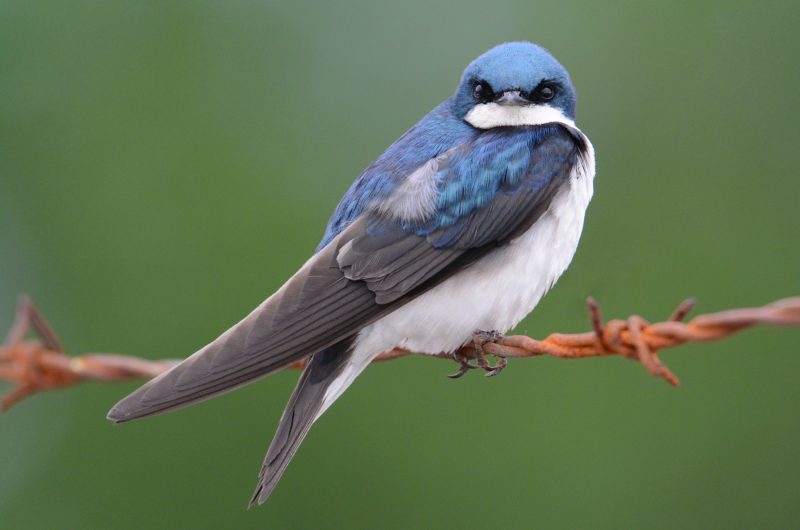
The Tree Swallow is a small, elegant bird with iridescent blue-green feathers on its back and bright white underparts. Its sleek appearance and agile flight make it a striking sight near wetlands, fields, and open woodlands. Males display more vibrant plumage than females, especially during the breeding season.
This species often nests in tree cavities or man-made nest boxes, making it a common visitor to birdhouses provided by nature enthusiasts. They are cavity-nesting specialists and are quick to take advantage of suitable sites when available. Their soft, chattering calls are often heard as they perch in small flocks.
Tree Swallows are known for their aerial feeding, snatching flying insects with remarkable precision. In North Carolina, they are seen throughout the breeding season and also during migration. During colder months, they may switch their diet to include berries, an unusual adaptation for swallows.
Chimney Swift
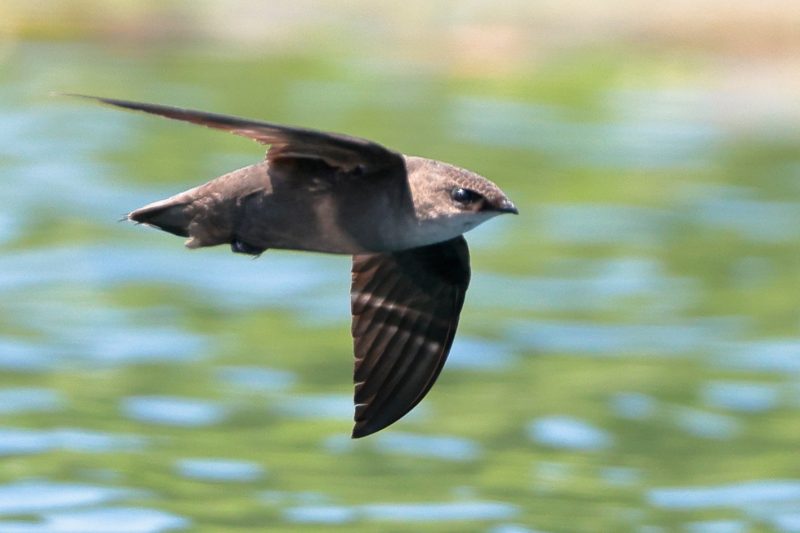
The Chimney Swift is a unique bird with a sooty-gray body and long, narrow wings that resemble a boomerang in flight. Lacking the ability to perch like most birds, it clings vertically to rough surfaces such as chimney walls or tree bark. Its fast, fluttering flight style often makes it look like a “flying cigar.”
Historically, Chimney Swifts nested in hollow trees, but they have adapted to human environments by using chimneys and similar structures. They form large communal roosts, and in late summer, thousands can be seen spiraling into chimneys at dusk. This behavior creates a spectacular viewing experience.
In North Carolina, they are present during the warmer months, arriving in spring and leaving by fall for South America. Their diet consists almost entirely of flying insects, making them valuable for natural pest control. They are especially active during evenings when insect activity is high.
Cedar Waxwing
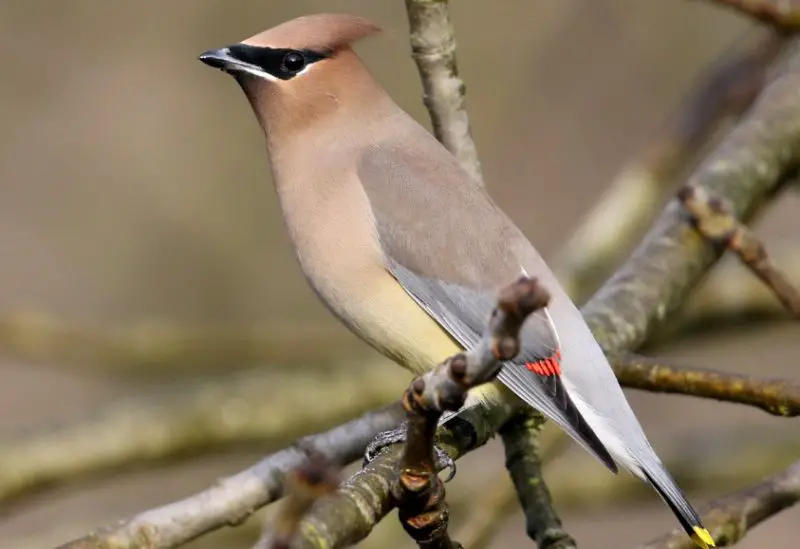
The Cedar Waxwing is a sleek, elegant bird with silky brown plumage, a pale yellow belly, and a distinctive crest. Its black mask and bright red wax-like tips on the wings give it a unique and stylish appearance. The tail is tipped with a band of yellow, completing its refined look.
These birds are highly social, often found in flocks, particularly during fall and winter. They feed heavily on fruits and berries, sometimes passing them from one bird to another before swallowing. In summer, they also consume insects, often catching them in mid-air.
Cedar Waxwings are present year-round in parts of North Carolina, though their numbers fluctuate depending on food availability. They are frequently seen in orchards, forests, and suburban areas with fruit-bearing trees and shrubs. Their soft, high-pitched whistles are a common sound when flocks pass overhead.
Yellow-rumped Warbler
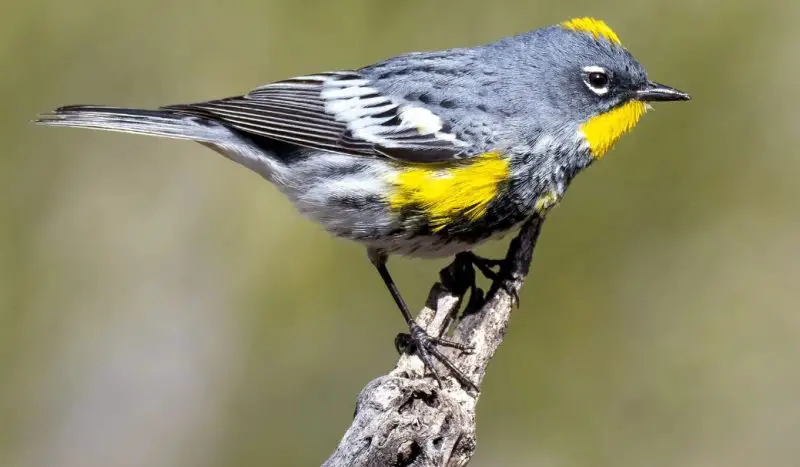
The Yellow-rumped Warbler is a small, active bird easily identified by the bright yellow patches on its rump, sides, and crown. Its plumage varies by season, with breeding males showing striking black, white, and yellow markings, while winter birds are duller but still recognizable.
Unlike many warblers, this species has a unique dietary advantage: it can digest waxes found in berries, such as those from wax myrtle and bayberry. This adaptation allows it to remain farther north in winter compared to other warblers.
In North Carolina, Yellow-rumped Warblers are common winter visitors, especially in woodlands, parks, and coastal areas. Their cheerful, chipping calls and fluttering movements make them a delight to observe as they forage among trees and shrubs.
Pine Warbler
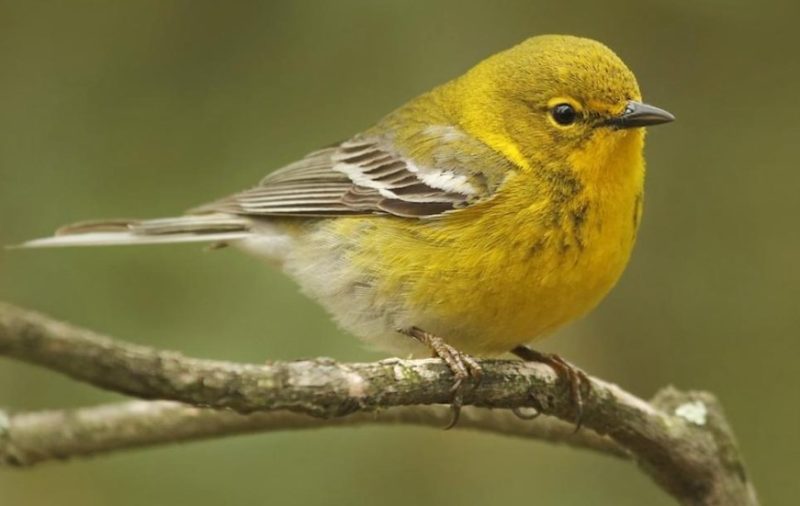
The Pine Warbler is a small songbird with olive-green upperparts and a yellow throat and breast. It often blends in with its pine forest habitat, where it spends much of its time foraging high in the trees. Its stout bill helps distinguish it from similar warbler species.
This warbler has a sweet, musical trill that resembles the song of a Chipping Sparrow, making careful listening important for proper identification. It is more likely than most warblers to visit bird feeders, particularly for suet and sunflower seeds.
In North Carolina, Pine Warblers are year-round residents, especially in areas with extensive pine forests. Their strong association with pines makes them one of the easier warblers to locate, particularly in the southeastern parts of the state.
Black-and-white Warbler

The Black-and-white Warbler is a small, striking bird known for its bold black-and-white striped plumage that runs from head to tail. Measuring about 4.3–5 inches long, it is slightly larger than many other warblers and has a distinctive, slightly curved bill adapted for gleaning insects from tree bark. Unlike most warblers, it creeps along trunks and branches like a nuthatch, making its feeding behavior unique.
In North Carolina, Black-and-white Warblers inhabit mature forests, woodland edges, and wooded riparian zones. They forage primarily on insects and spiders, probing bark crevices and foliage for hidden prey. Their habit of creeping up and down trees while searching for insects makes them easy to spot for careful observers.
Breeding occurs in the spring, with females building nests on the ground, often hidden at the base of roots or shrubs. A fun fact is that their distinctive “teck-teck-teck” song helps birders locate them despite their camouflaged plumage and active movement.
Prothonotary Warbler

The Prothonotary Warbler is a bright, eye-catching warbler with vivid golden-yellow underparts, bluish-gray wings, and an olive back. Measuring about 5 inches long, it is one of the few warblers in North Carolina that nests in cavities rather than open cup nests, often taking over old woodpecker holes or nest boxes in swampy areas.
These warblers prefer wooded wetlands, flooded forests, and river edges where water and abundant insects are available. They feed mainly on insects, spiders, and small crustaceans, gleaned from foliage or caught in short aerial sallies. Their loud, ringing “pro-te-ar-y” song is a signature sound of southern wetlands during the breeding season.
Breeding occurs from April through July, with females laying 3–7 eggs per clutch. A fun fact is that Prothonotary Warblers are sometimes called “swamp warblers” due to their affinity for watery habitats, and their vibrant coloration makes them particularly striking among cavity-nesting birds.
Ovenbird
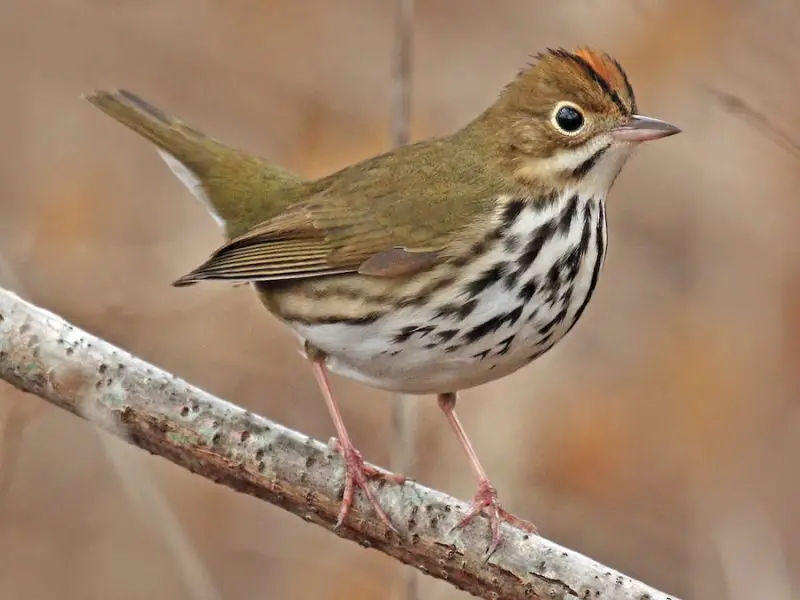
The Ovenbird is a small, ground-dwelling warbler measuring about 5–6 inches long. It is easily recognized by its olive-brown upperparts, white underparts streaked with black, and a bold orange crown stripe bordered by black. Unlike most warblers, it spends much of its time on the forest floor, using its strong legs to hop through leaf litter in search of insects.
In North Carolina, Ovenbirds inhabit mature deciduous and mixed forests, preferring shaded areas with dense leaf litter. They feed primarily on insects, spiders, and other invertebrates, probing soil and fallen leaves with their pointed bills. Their loud, ascending “teacher-teacher-teacher” song is commonly heard in spring and early summer, making them easy to locate despite their secretive nature.
Nesting occurs on the ground in dome-shaped nests that resemble small ovens, which gives the species its name. Females lay 4–6 eggs per clutch. A fun fact is that their oven-like nests are built with leaves and moss and often camouflaged so well that predators frequently overlook them.
FAQs about Common Birds in North Carolina
What are the most common birds found in North Carolina?
North Carolina hosts a variety of birds including Northern Cardinal, American Robin, Carolina Wren, Blue Jay, Eastern Bluebird, and Ruby-throated Hummingbird. The state’s mix of forests, wetlands, and urban areas provides habitats for both year-round residents and migratory species.
When is the best time to see birds in North Carolina?
Spring (March–May) and fall (September–November) are the best times for birdwatching. During these periods, migratory birds pass through the state, and many species are actively singing and breeding, making them easier to spot.
What habitats do North Carolina birds prefer?
Different species occupy varied habitats. Forest edges, woodlands, wetlands, and backyard gardens are common areas. Water-associated birds like Belted Kingfishers prefer rivers and lakes, while warblers and flycatchers are more abundant in forests and wooded areas.
How can I attract birds to my backyard in North Carolina?
Providing feeders with seeds, suet, and nectar for hummingbirds can attract many species. Planting native shrubs and fruiting trees helps provide natural food sources. Water features like birdbaths or small ponds also increase backyard bird activity.
Are there any endangered or protected birds in North Carolina?
Yes. Birds like the Red-cockaded Woodpecker are federally endangered and protected. North Carolina follows both federal and state regulations to protect habitats and nesting areas for sensitive bird species.
What should I know about migratory birds in North Carolina?
Many birds in North Carolina, including Indigo Buntings, Yellow-rumped Warblers, and Ovenbirds, are migratory. They breed in the state during spring and summer and migrate south for winter. Observing their migration patterns is popular among birdwatchers.
Can I safely feed birds in winter?
Yes. Providing high-energy foods such as sunflower seeds, suet, and cracked corn can help birds survive cold winters. Make sure feeders are clean and located in safe areas to prevent predation by cats or other animals.
How do I identify North Carolina warblers?
Warblers can be identified by their plumage, song, and behavior. Many warblers, like the Black-and-white Warbler, are insectivorous and forage on trees, while others, like the Pine Warbler, are more likely to be found in pine forests. Using a field guide or birding app can make identification easier.

